Here's an interesting thing to make!
You need to start with a square piece of paper, which you can make by taking a sheet of paper and folding one corner over to the opposite side as in the picture.
Carefully cut off the strip of paper below the triangle that you just created. Save this strip of paper for the Straw Rocket below!
|
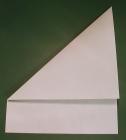
|
|
Open up the square piece of paper, then fold it in half.
|

|
|
Fold it in half again.
|

|
|
Open it up, then fold it in half the other way.
|

|
|
Fold it in half again.
|

|
Cut out the 4 squares in the middle.
Write the numbers in each square as in the picture (some of the numbers will be upside down).
On the right-hand side of the picture, notice that the paper is cut between the 2 and the 1.
|
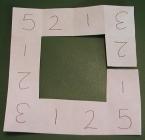
|
Turn the paper over and write the numbers in each square as in the picture.
In the bottom left corner there is a 6. Fold the paper to the right along the blue line so that the 6 in the corner is on top of the 6 next to it.
In the bottom right corner there is a 4. Fold the paper down along the red line so that the 4 in the corner is covered by the 4 above it.
|
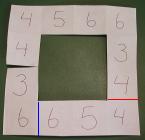
|
Now the bottom row has 3 1 2 5.
Fold down along the blue line so that the 2 is
behind
the 3.
Fold the bottom row to the right along the red line so that it goes
behind
the 5.
|
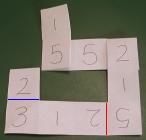
|
Fold to the right along the blue line so that the 5 on the left covers the 5 next to it.
Fold up along the red line so that the 1 goes
behind
the 2.
|
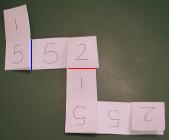
|
|
Fold to the left along the red line so that the 1 goes
behind
the 2, then tuck the end so that the 3 on the right (in the picture) is on top of the 3 on the left.
|
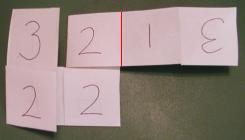
|
Place a piece of tape at the top of the 2 in the top left corner, then bend the tape behind the 2 so that it sticks to the 1 on the other side.
You have finished making your Flexagon!
Now you have a square piece of paper with two "faces." One face has the number 2 all over it, and the other face has the number 1 all over it. It's kind of like having dice with only the numbers 1 and 2. Normal dice have 6 faces, but this one only has 2 faces.
Or does it?
|

|
|
With the "2" face in front of you (and the "1" face on the other side), bend the Flexagon in the middle as in the picture.
|
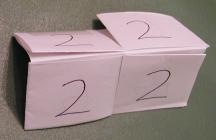
|
When you bend it all the way back, it will open up at the crease.
Where did the "3" face come from?
|

|
Turn the Flexagon over so that you're looking at the "2" face again, then "flex" it just like you did above. You should be looking at the "1" face. Turn it over so that you're looking at the "2" face again.
Now bend the "2" face in the middle the other way (as in the picture).
|

|
Open it at the crease.
Where did the "5" face come from?
This Flexagon actually has 6 faces, just like regular dice! Can you find the "6" face by flexing the Flexagon in different ways?
The prefix "tetra" means "four," and the prefix "hexa" means "six." Since this is a 6-faced, 4-sided Flexagon, it is called a HexaTetraFlexagon. There are lots of other Flexagons you can make (such as DodecaHexaFlexagons, which have 12 faces and 6 sides!), and you can find them by searching the Internet for "flexagon".
|

|
Years ago I invented a "FlexaMaze" in which you must follow a line from the Start to the Finish through all of the faces.
I used a HexaHexaFlexagon (6 faces and 6 sides), as shown in the picture. I submitted it to Games Magazine years ago, but I have no idea if they ever published it.
See if you can make your own FlexaMaze!
|
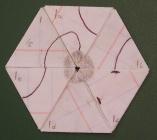
|